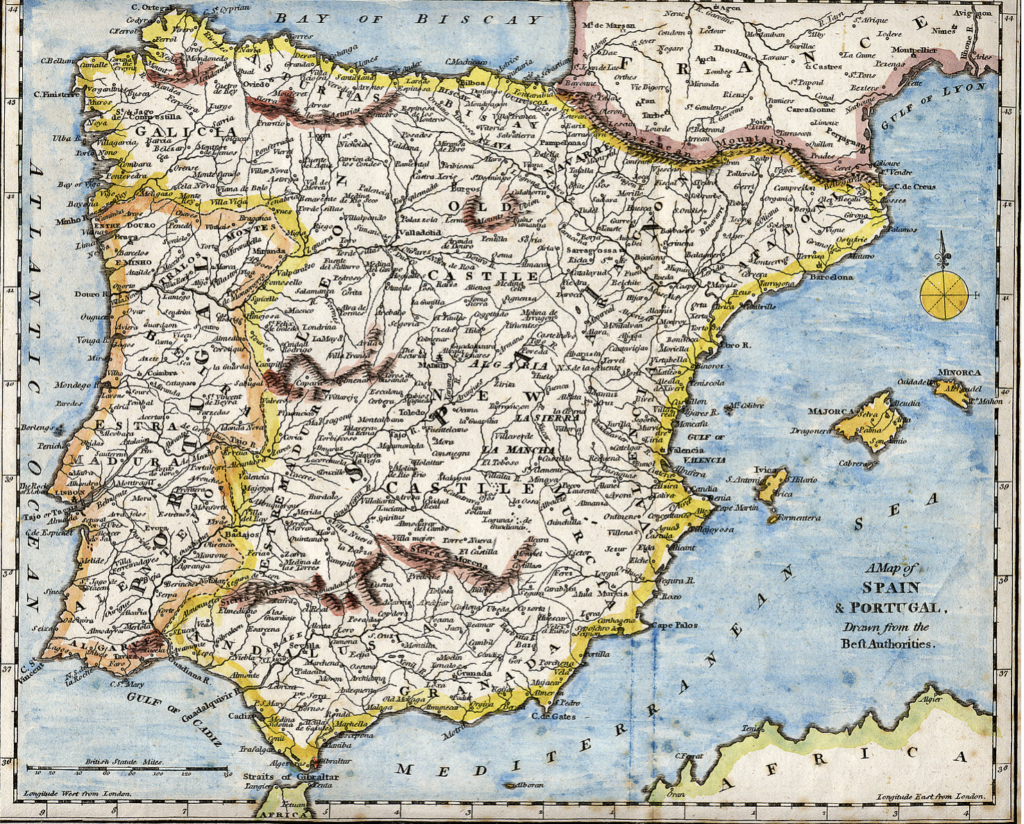The Andalusian Legacy: Traces of Arab Culture in Spain

Iberian Peninsula. Photo source: Wikimedia Commons
By: Rania Basria / Arab America Contributing Writer
Spain’s rich and lively past is closely linked to the influence of Arab-Muslim civilization. From 711 to 1492, Al-Andalus, a Muslim-ruled province on the Iberian Peninsula, served as a cultural, scientific, and intellectual bridge between the Islamic world and medieval Europe. The Andalusian legacy, produced by Arab, Berber, and indigenous Spanish communities, had a lasting impact on Spanish culture, architecture, language, and traditions. Arab America, content contributing writer Rania Basria dives into this heritage, and how it can still be found in many aspects of modern Spain, testifies to centuries of cultural interchange and coexistence.
The history of Arab influence in Spain began in 711, when Muslim soldiers, mostly Berbers from North Africa, crossed the Strait of Gibraltar and quickly captured much of the Iberian Peninsula. For centuries, Al-Andalus thrived under many caliphates and dynasties, most notably the Umayyad Caliphate in Córdoba. During this time, the region became a hotbed of cultural, scientific, and philosophical innovation, unparalleled in medieval Europe.
During the age of coexistence, also known as convivencia, Muslims, Christians, and Jews lived and worked together. This interaction not only promoted intellectual advancement, but also allowed for the merging of traditions and rituals, creating a lasting impact long after the final Muslim state, Granada, fell in 1492.
Architectural marvels of Al-Andalus
One of the most prominent manifestations of Arab culture in Spain is its architecture, which reflects the complexity and creativity of Al-Andalus. Arab style is distinguished by the use of complicated geometric patterns, horseshoe arches, and rich calligraphy, which can be found in many notable structures around Spain.
The Alhambra in Granada: Perhaps the most famous example of Andalusian architecture, the Alhambra is a large palace complex that exemplifies the magnificence of the Nasrid Dynasty. Its beautiful stucco work, peaceful courtyards, and magnificent tile mosaics are a tribute to Islamic aesthetics.
The Great Mosque of Córdoba: This architectural wonder combines Islamic and Christian influences. The ancient mosque, with its stunning red-and-white striped arches, was converted into a cathedral following the Reconquista, resulting in a unique blend of forms.
The Giralda in Seville was once a minaret for the city’s mosque before being turned into a bell tower for the Seville Cathedral. Its exquisite proportions and Moorish design are a reminder of the city’s Islamic heritage.
Scientific and Intellectual Advancements
Al-Andalus was not only a hub for building and language, but also a beacon of scientific and intellectual growth. Scholars in Al-Andalus translated and preserved the works of Greek and Roman philosophers, igniting the European Renaissance. Astronomy and Mathematics: Andalusian astronomers and mathematicians, such as Al-Zarqali (Arzachel), contributed significantly to our understanding of celestial mechanics and algebra. Medicine: The works of Andalusian physicians, such as Ibn Zuhr (Avenzoar), transformed medical practice and were studied in European institutions for decades. Philosophy: Thinkers such as Ibn Rushd (Averroes) connected Islamic and Western intellectual traditions, influencing both Christian and Jewish scholars.
While the Reconquista ended Muslim control in Spain, the cultural fusion that defined Al-Andalus influenced Spanish identity. Despite its limitations, the spirit of convivencia reminds us of the possibility of cohabitation among varied cultures. This history is commemorated in festivals, academic studies, and public awareness initiatives across Spain.
For example, places such as Granada and Córdoba offer annual events that promote Andalusian history and culture, attracting tourists from all over the world to enjoy the beauty and depth of this shared heritage.
Preserving the Andalusian legacy
Today, the Andalusian legacy continues to inspire and captivate people all over the world, not just Spaniards. Museums, rehabilitation initiatives, and cultural organizations strive ceaselessly to protect the relics of this rich past.
The story of Al-Andalus is more than just a chapter in Spanish history; it serves as a reminder of the fundamental ways in which cultures may influence and enrich one another. It demonstrates the enduring power of art, knowledge, and human connection.
The Arab influence on Spain is a profound legacy that continues to shape the country’s identity. From the majestic Alhambra to the everyday words in the Spanish language, the traces of Al-Andalus remind us of a time when cultures converged to create something extraordinary. In a world often divided by differences, the Andalusian legacy serves as a timeless example of how diversity can lead to brilliance, beauty, and progress.
Check out Arab America’s blog here!








